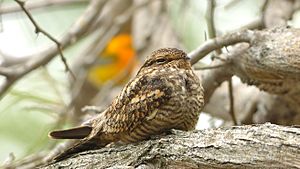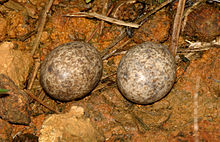Texas nightjar
| Texas nightjar | ||||||||||
|---|---|---|---|---|---|---|---|---|---|---|

Texas nightjar |
||||||||||
| Systematics | ||||||||||
|
||||||||||
| Scientific name | ||||||||||
| Chordeiles acutipennis | ||||||||||
| ( Hermann , 1783) |
The Texas nightjar ( Chordeiles acutipennis ) is a species of bird in the nightjar family (Caprimulgidae).
It occurs in Bolivia , Brazil , Chile , Costa Rica , Ecuador , French Guiana , Guyana , Colombia , Mexico , Panama , Paraguay , Peru , Suriname , Trinidad and Tobago , USA , Venezuela and the Yucatán Peninsula .
Their range includes all open habitats including deserts and semi-deserts , areas overgrown with bushes or grass, preferably near mangroves or swamps up to the lower highlands .
description
The Texas nightjar is 19–23 cm tall; the male weighs 34–62 g and the female 34–64 g. The Texas nightjar is very similar to the falcon nightjar : the plumage is dark brown or gray-brown. The throat is yellowish brown in the female, white in the male, which also has a white tail band. Young birds are paler, the throats even less colored. The distinguishing feature is the pale wing band that can be seen more in the direction of the wing tip in flight (white in males, yellow-brown in females). In the resting position, mostly lengthways on low branches, preferably mangroves, the wing tips reach to the tail tips.
voice
The male's call is described as a steady trill or slow purr. Frog-like moaning or whiny.
Geographic variation
The following subspecies are recognized:
- C. a. texensis Lawrence , 1856 - southwest of the USA to Mexico, winters in Colombia
- C. a. micromeris Oberholser , 1914 - Northern Yucatán Peninsula, southeastern Mexico
- C. a. littoralis Brodkorb , 1940 - southern Mexico, Costa Rica to Panama
- C. a. acutipennis ( Hermann , 1783), nominate form - Colombia, Venezuela, Trinidad and Tobago, in the Guyanas , Brazil, northern Bolivia to Paraguay
- C. a. crissalis A. H. Miller , 1959 - South Colombia, (upper valley of the Río Magdalena , in Huila)
- C. a. aequatorialis Chapman , 1923 - Western Colombia, Ecuador, possibly also northwestern Peru
- C. a. exilis ( Lesson , 1839) - Western Peru and rarely in the extreme north of Chile
Way of life
The diet consists of crickets , beetles , winged ants , moths , mayflies , termites , dragonflies and mosquitoes . The bird is crepuscular and hunts flying in loose groups.
The breeding season is between late April and August in the US, May to August in Mexico, possibly late April to July in El Salvador and March to July in Costa Rica.
Hazardous situation
The Texas nightjar is not considered to be endangered ( Least Concern ).
Individual evidence
- ↑ Avibase
- ↑ a b c d e Handbook of the Birds of the World
- ^ A b c G. R. Angehr, R. Dean: The Birds of Panama. Ithaca: 2010 ISBN 978-0-8014-7674-7
- ^ A b R. Garrigues, R. Dean: The Birds of Costa Rica. Ithaca: 2007. ISBN 978-0-8014-7373-9
- ^ M. McMullan: Field Guide to the Birds of Colombia Rey Naranjo Editores, 2018, ISBN 978-958-8969-77-0
- ^ IUCN Redlist
Web links
- Videos, photos and sound recordings for Chordeiles acutipennis in the Internet Bird Collection
